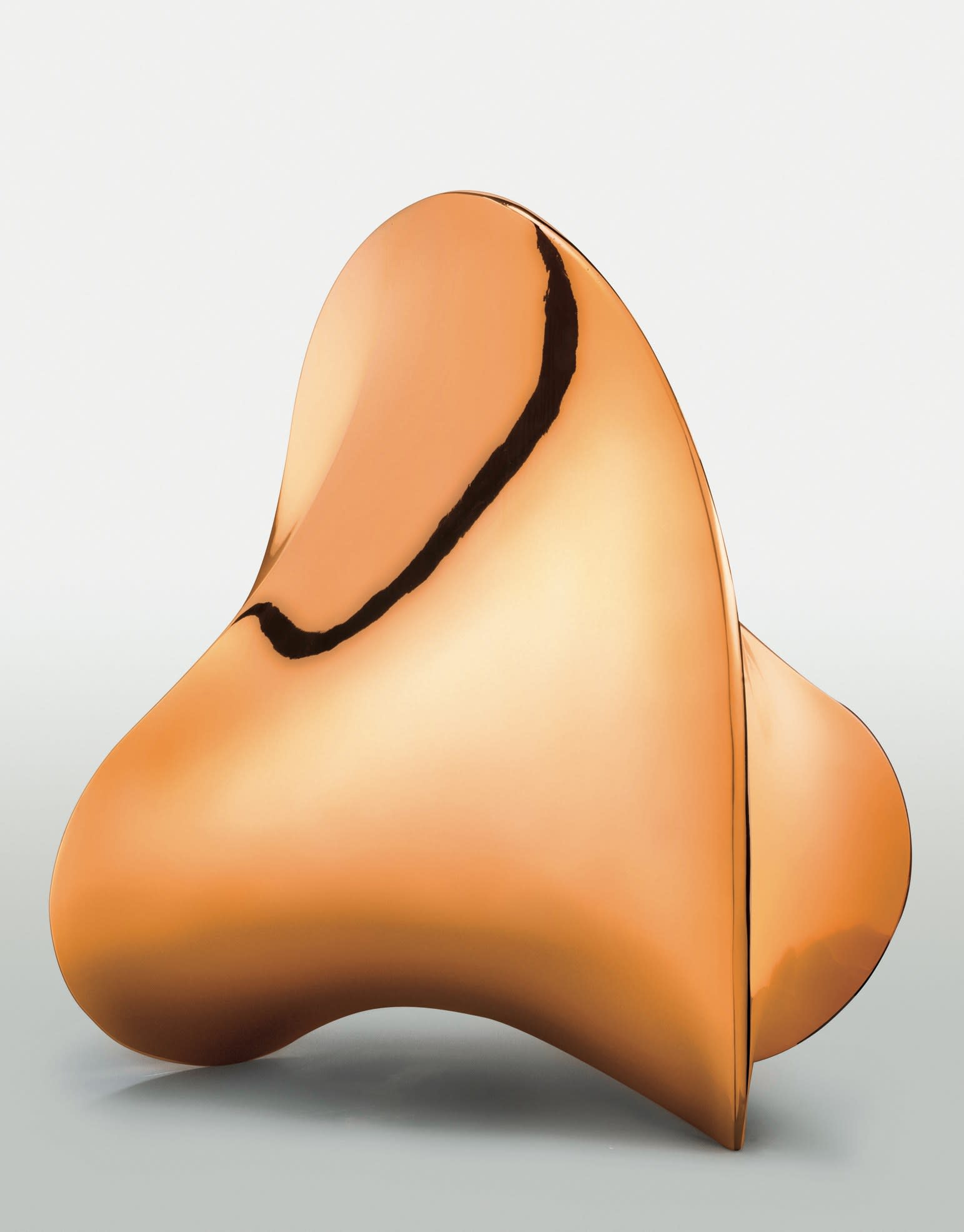Agostino Bonalumi
b. 1935, Vimercate, Italy
d. 2013, Desio, Italy
Bronzo (Bronze)
1969–2007
Bronze
60 x 58 x 50 cm (23 5/8 x 22 7/8 x 19 3/4 in.)
Edition 5/7
Provenance
Purchased from the Archivio Bonalumi, 2015,
Private Collection.
Literature
F. Pola, Bonalumi Sculture, exhibition catalogue, Turin, 2014, p. 267 (another example of the same edition).
F. Bonalumi and M. Meneguzzo, Agostino Bonalumi. Catalogue Raisonné, Milan, 2015, II, illustrated p. 436, no. 452.
Talenti e leggende: il Palazzo di Brera si racconta, exhibition catalogue, Milan, 2015, pp. 76–77 (another example of the same edition).
Description
Born in 1935, Agostino Bonalumi was a painter, draughtsman and sculptor. His first exhibition in 1958, with Piero Manzoni and Enrico Castellani at Galleria Pater, in Milan, showcased pre-pop compositions made up of objects which had been glued onto canvases (shirts, underwear, and metallic tubes mummified in layers of concrete).The artist took part in further exhibitions the following year, but it was the period between 1958 and 1960 that was particularly important for him. It was around that time that he started producing his first monochrome works with their padded elements that were later defined as "shaped canvases". He also held shows in Rome, Milan and Lausanne, as well as founding the Azimuth magazine and participating in exhibitions at the Azimut gallery.
Bonalumi began developing the idea of what he would call “pittura – oggetto” (painting-object), following the idea to go beyond the canvas started by his mentor Lucio Fontana. In 1959 he held his first solo show outside Italy in Rotterdam. In 1960 he was one of the founders of the international Nouvelle École Européenne (NEE) movement in Lausanne and his solo exhibition “Agostino Bonalumi. Recent Paintings, Sculptures and Drawings” opened at the New Vision Centre Gallery in London.
Bonalumi also had close links with the international Zero movement (both in the Netherlands and Germany), documented by major exhibitions such as “Zero” in London, 1964. It was during this exhibition that his talent became outstandingly clear in comparison to the other artists working with the same technique. His bi-/three-dimensional explorations in forms, shapes and shadows were indeed more natural and fluid than in the case of other artists.
In Bonalumi's career it is possible to highlight several different phases: in the first stage he produced monochrome paintings with padded elements that, applied to the back of the canvas, formed extruded shapes; these artworks were defined by Bonalumi as estroflessioni (extroflections). From 1965 onwards, new shapes were added to create asymmetrical elements that unbalanced the paintings, these elements would literally break the boundaries between the canvas and the object stretching it. In a third phase wooden elements formed three-dimensional bodies that literally broke the surface and he continued his research into new dimensions with an emphasis on sinuous shapes in a fourth stage of his practice. Bonalumi introduced then in his works oil, ciré, nylon, fabric; elements that substituted canvas, but the main aim of his explorations - going beyond things and looking at objects transforming the space - remained the same.
The bronzes of Bonalumi are the models from the 1960s that are once again brought to life, they are the same yet different, given that casting them in bronze confirms the lines, although variation in the matter used causes the outflow of the effect of light. “You see, bronze has to become live material. It has to induce a warm sensation, as organic material. It has to induce a warm sensation, as organic matter, and it has to have and emit the light of the August sun”. Agostino Bonalumi
Bonalumi began developing the idea of what he would call “pittura – oggetto” (painting-object), following the idea to go beyond the canvas started by his mentor Lucio Fontana. In 1959 he held his first solo show outside Italy in Rotterdam. In 1960 he was one of the founders of the international Nouvelle École Européenne (NEE) movement in Lausanne and his solo exhibition “Agostino Bonalumi. Recent Paintings, Sculptures and Drawings” opened at the New Vision Centre Gallery in London.
Bonalumi also had close links with the international Zero movement (both in the Netherlands and Germany), documented by major exhibitions such as “Zero” in London, 1964. It was during this exhibition that his talent became outstandingly clear in comparison to the other artists working with the same technique. His bi-/three-dimensional explorations in forms, shapes and shadows were indeed more natural and fluid than in the case of other artists.
In Bonalumi's career it is possible to highlight several different phases: in the first stage he produced monochrome paintings with padded elements that, applied to the back of the canvas, formed extruded shapes; these artworks were defined by Bonalumi as estroflessioni (extroflections). From 1965 onwards, new shapes were added to create asymmetrical elements that unbalanced the paintings, these elements would literally break the boundaries between the canvas and the object stretching it. In a third phase wooden elements formed three-dimensional bodies that literally broke the surface and he continued his research into new dimensions with an emphasis on sinuous shapes in a fourth stage of his practice. Bonalumi introduced then in his works oil, ciré, nylon, fabric; elements that substituted canvas, but the main aim of his explorations - going beyond things and looking at objects transforming the space - remained the same.
The bronzes of Bonalumi are the models from the 1960s that are once again brought to life, they are the same yet different, given that casting them in bronze confirms the lines, although variation in the matter used causes the outflow of the effect of light. “You see, bronze has to become live material. It has to induce a warm sensation, as organic material. It has to induce a warm sensation, as organic matter, and it has to have and emit the light of the August sun”. Agostino Bonalumi




